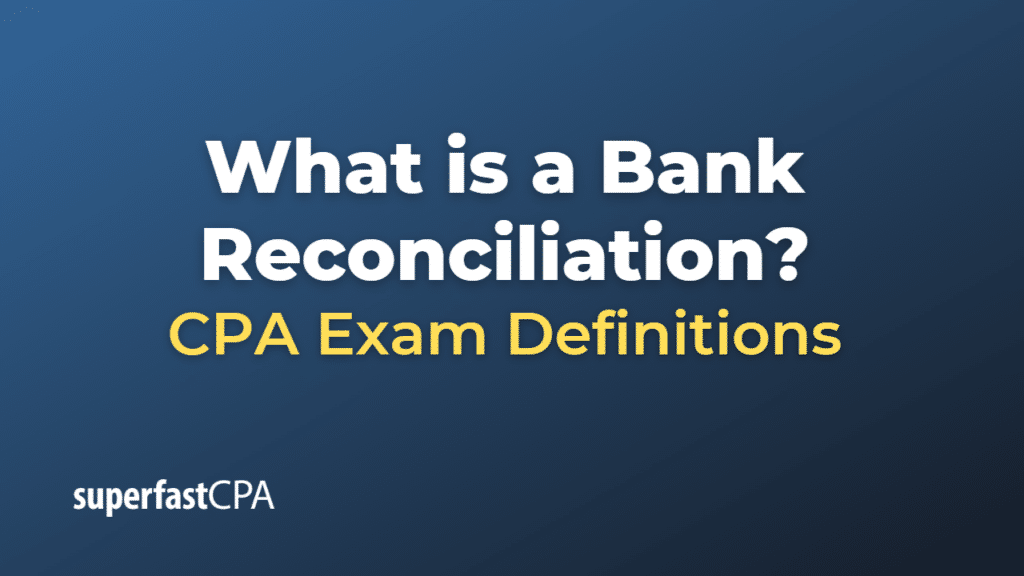Bank Reconciliation
A bank reconciliation is a financial process that involves comparing a company’s or individual’s internal financial records with their bank statement to ensure that both sets of records are accurate and consistent. The primary purpose of a bank reconciliation is to identify any discrepancies, errors, or unauthorized transactions and to verify that all transactions have been properly recorded and processed.
Bank reconciliations are typically performed on a regular basis, such as monthly, to ensure the accuracy and integrity of financial records. The process generally involves the following steps:
- Obtain bank statement: Obtain the most recent bank statement, which typically includes the account balance, deposits, withdrawals, fees, and other transactions for a specific period.
- Compare internal records with the bank statement: Review and compare the internal financial records (e.g., general ledger or cash book) with the transactions listed on the bank statement. Pay close attention to any differences or discrepancies.
- Identify discrepancies: Note any differences between the internal records and the bank statement, such as outstanding checks, deposits in transit, bank errors, or unauthorized transactions.
- Investigate and resolve discrepancies: Investigate the cause of any discrepancies and take appropriate action to correct errors or address unauthorized transactions. This may involve contacting the bank or updating the internal financial records to reflect the correct information.
- Adjust internal records: Once all discrepancies have been identified and resolved, update the internal financial records to accurately reflect the reconciled bank statement balance.
- Document the reconciliation: Prepare a formal bank reconciliation statement or report that details the reconciled account balance and any adjustments made during the process.
Bank reconciliations are an essential part of maintaining accurate financial records and ensuring the security of financial assets. They can help identify errors, fraud, or unauthorized transactions, and provide valuable information for financial planning and decision-making.
Example of a Bank Reconciliation
Let’s consider an example of a small business owner performing a monthly bank reconciliation for their business checking account.
- Obtain bank statement: The business owner receives their bank statement for the month of March, which shows an ending balance of $8,500.
- Compare internal records with the bank statement: The business owner reviews their cash book (internal financial records) for the same period and finds an ending balance of $8,200.
- Identify discrepancies: The business owner notices some differences between their cash book and the bank statement:
- A deposit of $500 made at the end of the month is recorded in the cash book but not yet reflected on the bank statement (deposit in transit).
- A check for $300 issued to a supplier is recorded in the cash book but has not yet cleared on the bank statement (outstanding check).
- A bank service fee of $100 is shown on the bank statement but not yet recorded in the cash book.
- Investigate and resolve discrepancies: The business owner verifies that the deposit in transit and the outstanding check are valid transactions that have not yet been processed by the bank. They also confirm that the bank service fee is accurate and should be recorded in the cash book.
- Adjust internal records: The business owner updates their cash book to account for the bank service fee:
- Cash book balance: $8,200
- Bank service fee: -$100
- Adjusted cash book balance: $8,100
- Document the reconciliation: The business owner prepares a bank reconciliation statement that shows the following:
- Bank statement balance: $8,500
- Deposit in transit: +$500
- Outstanding check: -$300
- Adjusted bank statement balance: $8,700
- Cash book balance: $8,200
- Bank service fee: -$100
- Adjusted cash book balance: $8,100
- Reconciliation difference: $8,700 (Adjusted bank statement balance) – $8,100 (Adjusted cash book balance) = $600
In this example, the business owner has identified and resolved discrepancies between their internal financial records and the bank statement. By performing the bank reconciliation, they have ensured the accuracy of their financial records and gained a better understanding of their cash position at the end of the month.













